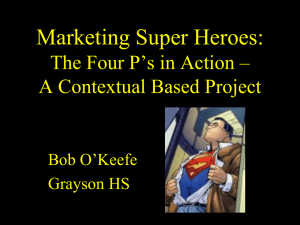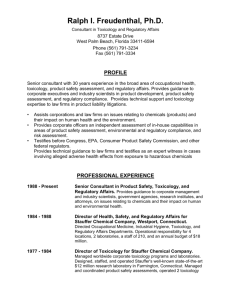Didactical Elements
advertisement
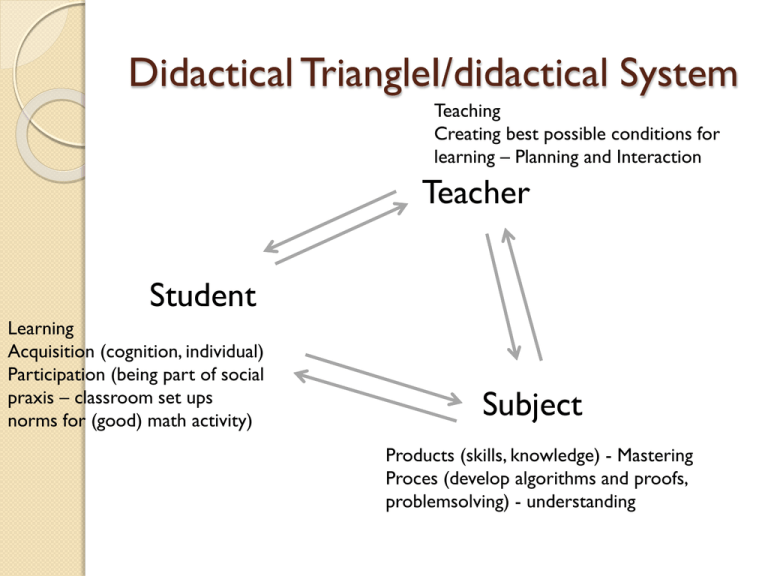
Didactical TriangleI/didactical System Teaching Creating best possible conditions for learning – Planning and Interaction Teacher Student Learning Acquisition (cognition, individual) Participation (being part of social praxis – classroom set ups norms for (good) math activity) Subject Products (skills, knowledge) - Mastering Proces (develop algorithms and proofs, problemsolving) - understanding The Theory of Didactical Situations - TDS Theory ? Knowledge TDS – Guy Brousseau TDS is in this context presented more like a didactic approach than a theory TDS – Guy Brousseau Knowledge is transformed/exchanged between 3 main groups of actors: Researchers Teachers Students For each group there is a distinction between two forms of subject knowledge – depending on the actor: • Personal knowledge (Implicit, contextual, explicit) • Shared/common/official knowledge (explicit, e.g. textbooks, articles) Learning means two processes: Shared knowledge Personal knowledge Shared knowledge TDS – Guy Brousseau Brousseau: •A teacher is normally asking questions of which he/she knows the answer – an artificial situation •Outside teaching-learning situations you ask questions in order to get an answer to what you did not know •Brousseau wants to overcome this paradox TDS – Guy Brousseau Brousseau: •Traditional teaching in Math and Science tend are in practice based on transfer •Student do not learn mathematics but they learn to decode teacher’s expectations •So students learn a certain perception of what mathematics is or what it is about TDS – Guy Brousseau Learning Intended Adidactical Situation Didactical Unintended Non - didactical TDS – Guy Brousseau Adidactical situation Teacher Adjusting Didactical variables acts Student Milieu (Subject) Didactical variabels Gets feed back VERY IMPORTANT Fundamental didactical situation: Utilizing/exploring the knowledge in question is a winner strategy in the situation TDS – Guy Brousseau Characteristics of a fundamental didactical situation: •Sufficient pre knowledge in order to understand the challenge and be able to suggest answers •Feed back incorporated so students’ strategies are validated without the teachers interference •Sufficient uncertainty (complexity) in order to avoid obvious beforehand judgements of suggested strategy •Possibility for trial and error – many attempts •The aimed knowledge must be a condition for reaching the new strategy TDS – Guy Brousseau The puzzle example TDS – Guy Brousseau Teacher role Student role Milieu Situation Devolution (handling over the challenge to the students Start Clarify Receive and understand Established didactical Action ( formulate and test strategies) Observe Reflect Act and reflect Field of research adidactical Statement/explanation (explains to other groups, stating hypothesis) Organize and ask Formulate, state more exactly Open discussion Adidactical or didactical Validation (reject/accept hypothesis) Listen and evaluate Argue, reason and reflect Guidet discussion, evaluation Normally didactical Institutionalizing (define the achieved knowledge) Present and explain Listen and reflect Institutional knowledge Didactical TDS – Guy Brousseau Do we know the Phases? Construct a didactical situation – state exactly the topic and the didactical variables. TDS – Guy Brousseau Example: logistic growth RME - Freudenthal Realistic Mathematics Education. Basic idea: Mathematics must be considered a special approach to solve problems related to the world outside RME - Freudenthal Methods and concepts are there but the student’s understanding is to be developed through more informal work with problems related to the world outside Guided reinvention: students are supposed to reason, develop, generalize and systematize their informal work RME - Freudenthal ”The learner should reinvent mathematising rather than mathematics, abtracting rather than abstractions, schematising rather than schemes, algorithmising rather than algorithms, verbalising rather than language” (Freudenthal) RME - Freudenthal Model concept – emergent models • activity based on the given context • referential level – a model of the given context is developed – reflect on the context • general level – the model becomes a model for situations in outside world – it gets it’s own life - reflect on the model – thinking with • formal level – pure mathematical investigations can be possible – the significance of parameters…Thinking about the model RME - Freudenthal Example:Taxi functions RME - Freudenthal ”By describing their own process students can use their reflections to develop flexible prototypes of experiences that can be drawn on in future problem solving” (Lesh & Zawojewski) ”A fresh view of problem solving needs to view the learning of mathematics and problem solving as integrated, as largely based on modelling activity, and as a construct that is itself continually in need of development” (Lesh & Zawojewski)

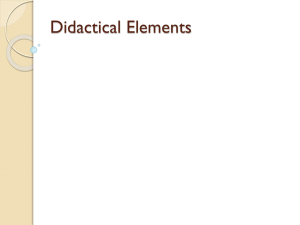
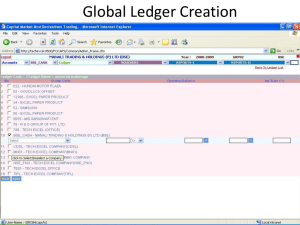

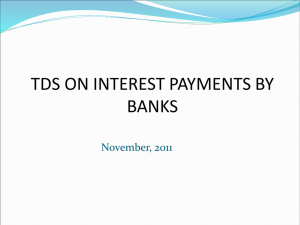
![The mysterious Benedict society[1]](http://s2.studylib.net/store/data/005310565_1-e9948b5ddd1c202ee3a03036ea446d49-300x300.png)


